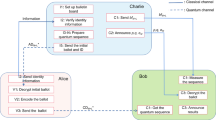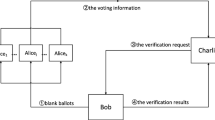Abstract
We propose a novel quantum voting protocol that utilizes superdense coding of four-particle entangled states. The protocol is simultaneously legitimate, anonymous, blind, verifiable and irreducible. In order to prevent malicious tampering of the public content, we introduce the distributed proof of work (PoW) consensus algorithm in blockchain as a database mechanism for voting participants. The voting protocol utilizes four-particle entangled states as a quantum resource to perform only single-particle operations, as well as GHZ basis measurements and \(\left\{ | 0 \rangle ,| 1\rangle \right\} \)-basis measurements. This means that our protocol can be successfully implemented using existing quantum information processing techniques. We conduct simulation experiments on the proposed voting protocol on the IBM Qiskit platform, and the results show that it is correct and feasible.






Similar content being viewed by others
Explore related subjects
Discover the latest articles, news and stories from top researchers in related subjects.Data Availability
The datasets analyzed during the current study are available from the corresponding author on reasonable request.
References
Simpson, V., Oliver, M.: Electronic voting systems for lectures then and now: a comparison of research and practice. Australas. J. Educ. Tech. 23(2), 187–208 (2007)
Gritzalis, D.A.: Principles and requirements for a secure e-voting system. Comput. Secur. 21, 539–556 (2002)
Hillery, M., Ziman, M., Bužek, V., Bieliková, M.: Towards quantum-based privacy and voting. Phys. Lett. A. 349, 75–81 (2006)
Vaccaro, J.A., Spring, J., Chefles, A.: Quantum protocols for anonymous voting and surveying. Phys. Rev. A. 75, 012333 (2007)
Yi, Z., He, G.Q., Zeng, G.H.: Quantum voting protocol using two-mode squeezed states. Acta Phys. Sin. 58, 3166–3172 (2009)
Bonanome, M., Bužek, V., Hillery, M., Ziman, M.: Toward protocols for quantum-ensured privacy and secure voting. Phys. Rev. A. 84, 022331 (2011)
Horoshko, D., Kilin, S.: Quantum anonymous voting with anonymity check. Phys. Lett. A. 375(8), 1172–1175 (2011)
Sharma, R.D., De, A.: Quantum voting using single qubits. Ind. J. Sci. Technol. 9(42), 032329 (2016)
Naseri, M., Gong, L.H., Houshmand, M., Matin, L.F.: An Anonymous Surveying Protocol via Greenberger-Horne-Zeilinger States. Int. J. Theor. Phys. 55, 4436–4444 (2016)
Wang, Q.L., Yu, C.H., Gao, F., Qi, H.Y., Wen, Q.Y.: Self-tallying quantum anonymous voting. Phys. Rev. A. 94(2), 022333 (2016)
Liu, X.H., Wen, X.J., Fan, X.C., Fang, J.B.: A secure quantum voting protocol based on four-particle GHZ states. Chin. J. Quantum Electron. 34, 721–727 (2017)
Wen, Q.Y., Qin, S.J., Gao, F.: Cryptanalysis of quantum cryptographic protocols. J. Cryptol. Res. 1, 200–210 (2014)
Niu, X.F., Zhang, J.Z., Xie, S.C., Chen, B.Q.: An improved quantum voting scheme. Int. J. Theor. Phys. 57, 3200–3206 (2018)
Thapliyal, K., Sharma, R.D., Pathak, A.: Protocols for quantum binary voting. Int. J. Quantum Inf. 15, 1750007 (2017)
Qin, J.Q., Shi, R.H., Zhang, R.: Quantum voting protocol based on controlled Quantum-Secure direct communication. Chin. J. Quantum Electron. 35, 558–566 (2018)
Qiu, C., Zhang, S.B., Chang, Y., Huang, X., Chen, H.: Electronic voting scheme based on a quantum ring signature. Int. J. Theor. Phys. 60, 1550–1555 (2021)
Qiu, S.J., Xin, X.J., Zheng, Q., Li, C.Y., Li, F.G.: Security analysis and improvements on a semi-quantum electronic voting protocol. Int. J. Theor. Phys. 63, 79 (2024)
Xu, Y.P., Gao, D.Z., Liang, X.Q., Xu, G.B.: Semi-quantum voting protocol. Int. J. Theor. Phys. 61, 78 (2022)
Yamagami, T., Segawa, E., Konno, N.: General condition of quantum teleportation by one-dimensional quantum walks. Quantum Inf. Process. 20, 224 (2021)
Li, H.W., Zhang, C.M., Jiang, M.S.: Improving the performance of practical decoy-state quantum key distribution with advantage distillation technology. Commun. Phys. 5, 53 (2022)
Bennett, C.H., Wiesner, S.J.: Communication via one- and two-particle operators on Einstein-Podolsky-Rosen states. Phys. Rev. Lett. 69, 2881–2884 (1992)
Bennett, C.H., Brassard, G.: Quantum cryptography: public-key distribution and coin tossing. Theor. Comput. Sci. 561(1), 7–11 (2014)
Mayers, D.: Unconditional security in quantum cryptography. J. ACM. 48, 351–406 (2001)
Shor, P.W., Preskill, J.: Simple proof of security of the BB84 quantum key distribution protocol. Phys. Rev. Lett. 85, 441–444 (2000)
Lo, H.K., Chau, H.F.: Unconditional security of quantum key distribution over arbitrarily long distances. Science 283, 2050–2056 (1999)
Wang, Y.: One-time pad security and new confidentiality system. Netinfo Secur. 41–43 (2004)
Rubin, F.: One-time pad cryptography. Cryptologia 20, 359–364 (1996)
Wei, C.Y., Cai, X.Q., Wang, T.Y., Qin, S.J., Gao, F., Wen, Q.Y.: Error tolerance bound in QKD-based quantum private query. IEEE J. Sel. Area. Comm. 38(3), 517–527 (2020)
Wang, T.Y., Cai, X.Q., Ren, Y.L., Zhang, R.L.: Security of quantum digital signatures for classical messages. Sci. Rep. 5, 9231 (2015)
Sun, X., Wang, Q., Kulicki, P., Sopek, M.: A simple voting protocol on quantum blockchain. Int. J. Theor. Phys. 58, 275–281 (2019)
Ryan, P.Y.A., Bismark, D., Heather, J., Schneider, S.: Zhe Xia: PrEt À Voter: a voter-verifiable voting system. IEEE Trans. Inf. Foren. Sec. 4, 662–673 (2009)
Canetti, R.: Universally composable security: a new paradigm for cryptographic protocols. In: Proceedings 42nd IEEE Symposium on Foundations of Computer Science. pp. 136–145. IEEE, Newport Beach, CA, USA (2001)
Jiang, D.H., Xu, G.B.: Multiparty quantum key agreement protocol based on locally indistinguishable orthogonal product states. Quantum Inf. Process. 17, 180 (2018)
Cao, H.J., Ding, L.Y., Jiang, X.L., Li, P.F.: A new proxy electronic voting scheme achieved by six-particle entangled states. Int. J. Theor. Phys. 57, 674–681 (2018)
Wang, J., Xu, G.B., Jiang, D.H.: Quantum voting scheme with Greenberger-Horne-Zeilinger States. Int. J. Theor. Phys. 59, 2599–2605 (2020)
Tian, J.H., Zhang, J.Z., Li, Y.P.: A quantum multi-proxy blind signature scheme based on genuine four-qubit entangled state. Int. J. Theor. Phys. 55, 809–816 (2016)
Zhang, J.L., Zhang, J.Z., Xie, S.C.: A Choreographed Distributed Electronic Voting Scheme. Int. J. Theor. Phys. 57, 2676–2686 (2018)
Funding
This work is supported by the National Natural Science Foundation of China (Grant No. 62171264) and Shandong Provincial Natural Science Foundation (Grant No.ZR2023MF080).
Author information
Authors and Affiliations
Contributions
All authors contributed equally to the paper.
Corresponding author
Ethics declarations
Conflict of interest
All authors certify that they have no affiliations with or involvement in any organization or entity with any financial interest or non-financial interest in the subject matter or materials discussed in this manuscript.
Additional information
Publisher's Note
Springer Nature remains neutral with regard to jurisdictional claims in published maps and institutional affiliations.
Rights and permissions
Springer Nature or its licensor (e.g. a society or other partner) holds exclusive rights to this article under a publishing agreement with the author(s) or other rightsholder(s); author self-archiving of the accepted manuscript version of this article is solely governed by the terms of such publishing agreement and applicable law.
About this article
Cite this article
Zhang, HW., Xu, GB. & Jiang, DH. Novel quantum voting protocol for four-particle entangled states based on superdense coding. Quantum Inf Process 24, 44 (2025). https://doi.org/10.1007/s11128-025-04663-3
Received:
Accepted:
Published:
DOI: https://doi.org/10.1007/s11128-025-04663-3




